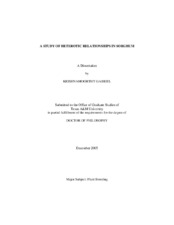| dc.description.abstract | In sorghum, a predominantly self-pollinated crop, hybrid seed production relies exclusively on the cytoplasmic-genetic male sterility system. The system of hybrid development has caused sorghum breeding programs to develop two breeding groups: a male-parent group (R-line/ fertility-restorer) and a female-parent group (an A/B line, lacking the fertility-restoring gene of the A1 male-sterility system). These have served as heterotic groups in the absence of more information with reference to genetic diversity. Efforts to determine heterotic groups in sorghum have not been successful in clearly delineating any patterns. However, in a recent molecular marker-based study of 50 elite sorghum parental lines, groups similar to the working group system were observed, as was an absence of a consistent delineation, characteristic of heterotic groups, between the A/B- and R-lines. This study was conducted with the objective of evaluating the groups observed and assessing their potential as heterotic groups. Two parental lines from each of the five groups, and two lines from those not conforming to any group, were chosen and crossed in a half-diallel. The twelve parents, sixty-six diallel hybrids and three commercial hybrid checks were evaluated for grain yield and other agronomic traits in five environments' College Station, TX in 2003 and 2004, Weslaco, TX in 2003, and Halfway, TX in 2003 and 2004. Within-group crosses exhibited inferior heterotic expression, for grain yield and other traits, in comparison with across-group crosses. Furthermore, genetic similarity estimates for parental line pairs obtained from the molecular study were significantly correlated with specific combining ability and heterosis for yield of the corresponding hybrid combinations, revealing a pattern of correspondence between molecular data and heterosis. Hybrids made among R-lines and among B-lines were significantly lower in yield compared to AxR hybrids, likely to be a result of decades of breeding efforts to develop inbreds within the mutually isolated groups, rather than a consequence of phylogenetic divergence. An examination of the heterotic effects manifested in hybrid combinations reveals a pattern of interactions broadly in agreement with the molecular data, but differential responses between individual members of the proposed groups make it difficult to define distinct heterotic groups. | en |


